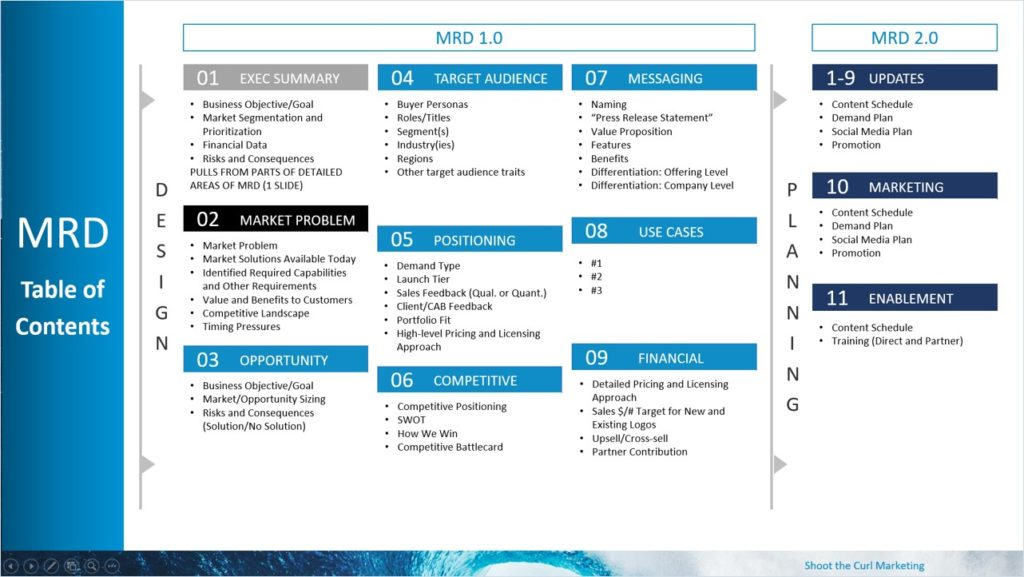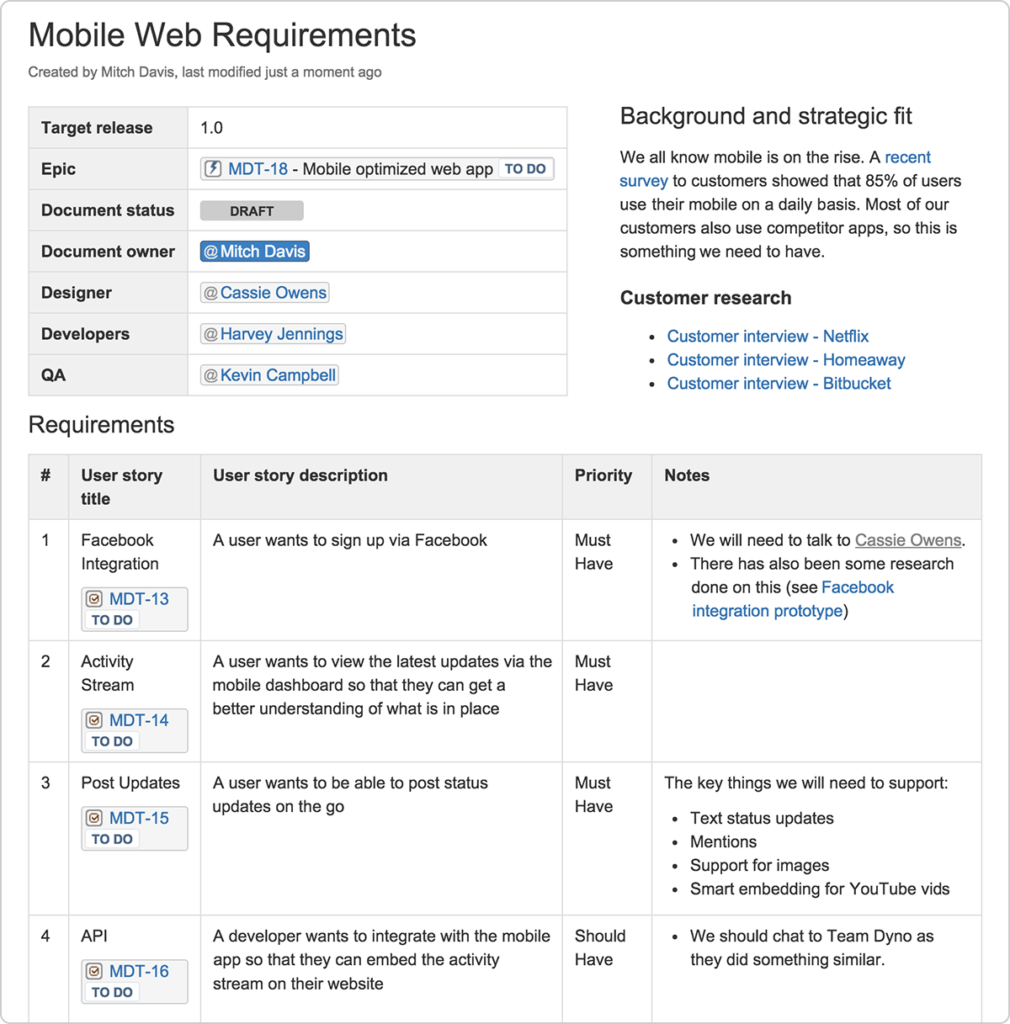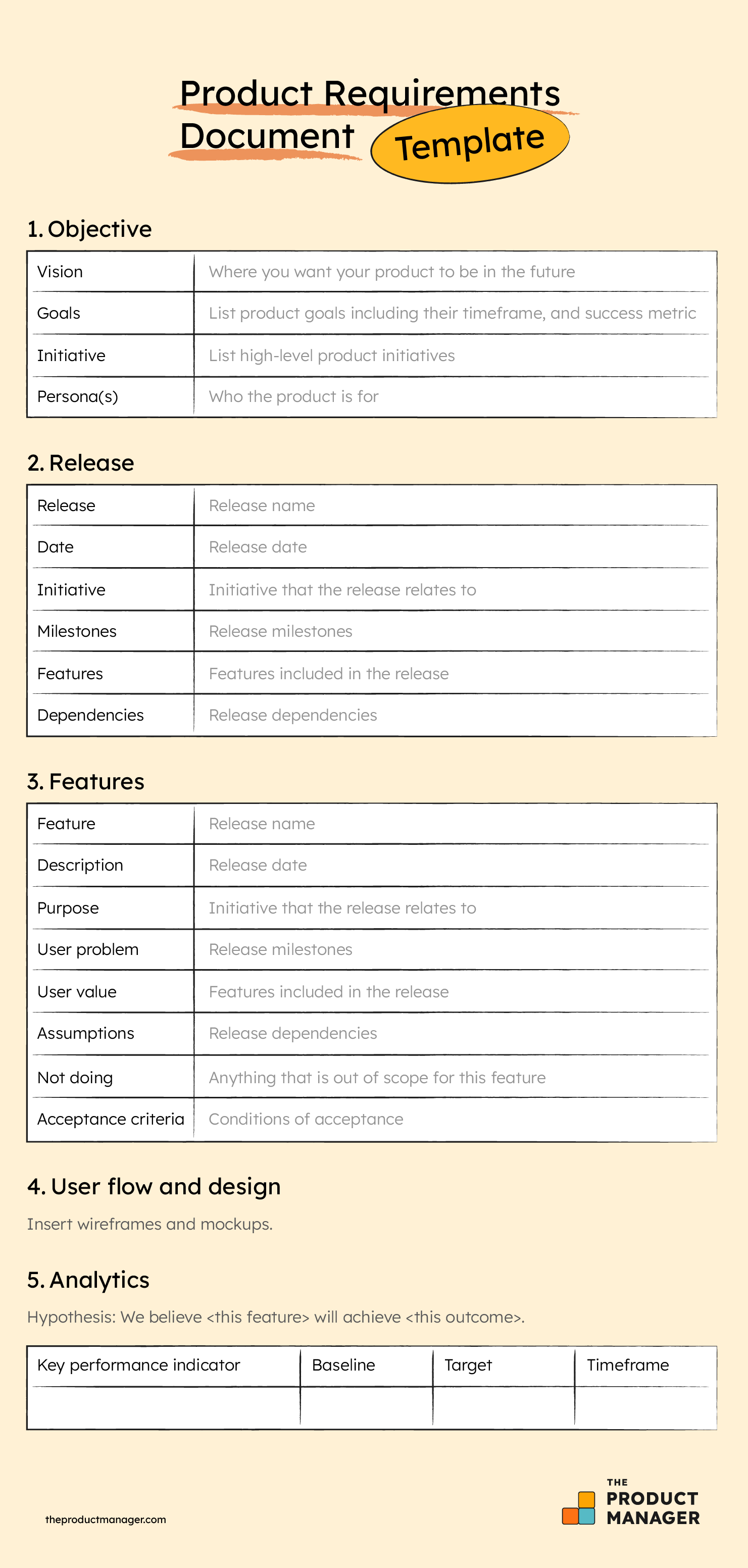Why are product requirement documents (or PRDs) such vital tools for product teams? Because no matter how clearly you can envision your product's future state, no two stakeholders will hear it the same way.

I'm sure there are a million horror stories out there from product managers who didn't realize how badly they've communicated the critical elements of a new product or feature until it was too late.
This is why a Product Requirements Document (PRD) is so crucial. It uses a comprehensive, systematic approach to get everyone aligned on what success should look like.
In this article, we'll take a deep dive into what a PRD is, the benefits of using one, the difference between a PRD and an MRD, and even throw in a template PRD to get you started creating your own.
What Is A Product Requirements Document (PRD)?

Simply put, a product requirements document details the features and functionality that must be included in a specific product release. It’s a crucial reference point for all teams involved in designing and developing a particular product. It's also essential for informing the product roadmap.
Traditionally used in a Waterfall methodology project environment—where the product development process is sequential—it can also be used in agile product management.
Several other documents can be created from the information captured within the PRD. Engineering may create a Technical Requirements Document detailing the product specifications and system requirements.
Business analysts may create a Functional Requirements Document detailing what happens when a user interacts with the system, including wireframes to show the product design.
User experience (UX) designers might create a User Interface Requirements Document that explains how the product should look and feel.
When should you use a product requirements document?
Creating a Product Requirements Document at the start of the product development process is vital. Once the business has determined there is a user need for the product, the PRD should be developed, sharing the exact capabilities required for the release.
What’s the difference between a PRD and an MRD?
A Market Requirements Document (MRD) details the market opportunity or customer demand for the product. It’s crucial for supporting the business case for product development and should be created before the PRD.

The MRD will usually contain a definition of the target market and provide a prioritized list of customer requirements the product will need to satisfy to be successful. This can then be used to shape the list of core capabilities described in the PRD.
The MRD will also usually suggest a timeframe for the product’s launch in order to take advantage of first-to-market positioning, if appropriate.
What Are The Benefits Of Writing A PRD?
There are several benefits of investing time in writing a comprehensive PRD. Let’s take a look at a few of them:
1. It gets all stakeholders on the same page
A well-developed PRD acts as a single source of truth for the many stakeholders involved in product development. It clearly details what will be delivered, any assumptions being made, the acceptance criteria, and a timeline for the release.
The PRD isn’t a static document; it can be updated throughout the product development process if customer or market requirements change. Ensuring it’s visible to everyone involved makes sure that product development teams have the most up-to-date and relevant information needed to complete the work.
The PRD should be shared with all stakeholders after initial sign-off by the customer and remain accessible through the development cycle for reference as needed. Using a product requirements software platform makes it simple for teams to agree on and prioritize requirements, draw up a PRD, and communicate effectively throughout the development process.

2. It makes it clear what’s out of scope
It’s just as important to detail what isn’t going to be developed as what is going to be developed. Many PRDs contain an ‘out of scope’ section that lists any features or functionality that aren’t going to be developed in the release.
Clarifying what’s out of scope is important to help developers stay on top of time and budget. Frequent scope change is one of the top reasons for project failure. Sometimes, more modest functionality that meets customers’ needs is a sensible trade-off compared to a gold-plated solution that takes longer and costs more money.
3. It fosters collaboration between teams
Product Requirements Documents aren’t created in a silo. At least, not good ones anyway. Creating an effective PRD requires cooperation and communication across multiple teams.
Business and marketing teams ensure the viability of the potential product by exploring market and customer requirements and securing leadership support and funding.
Business analysis and UX teams offer input around usability and functional requirements. And engineering teams provide systems knowledge to make sure the technical infrastructure is in place to support the product.
Collaboration — and the occasional compromise — across functional areas ensure alignment and allow the PRD to become a helpful central reference point for all teams.
4. It puts the customer’s perspective at the heart of the product
It may seem obvious that we should be developing products with the customer in mind.
But sometimes, among all the other voices, it’s easy to forget who we’re actually designing for:
The PRD uses input from the MRD to create a list of the core features and functionality likely to be valuable to users. Customer research and market analysis form the backbone of the MRD and ensure the end-user is well-represented.
Where the customer is a business stakeholder, the PRD clearly details the product they should expect to receive and the timeline for its development. Detailed acceptance criteria clarify the functionality, usability, reliability, supportability, and performance levels required for a successful release.
What Should A Product Requirements Document Contain?
Let’s take a quick rundown of what exactly a PRD should contain.

Document metadata
The PRD is a living document and is subject to change. Appropriate metadata helps you to track and store the document appropriately.
Product objectives
A clear problem statement, sharing exactly what developing the product should help the business achieve, keeps everyone focused on the overall goal.
Customer research
In this section, add any helpful customer or market research that might influence the product development process. A link to the MRD can be included.
Features
Arguably the most crucial section of your PRD, use this part to list all the agreed product use cases, capabilities, features, and functionality you’re going to deliver in the release. In Agile development, this section might include user stories, and you might also include UX design notes.
Negative scope
Make sure to also detail what won’t be included in the release. Some of these elements might be scoped as potential future enhancements.
System and environment requirements
Using input from your engineering team, detail any system and environment requirements here.
Assumptions, constraints, and dependencies
It’s always worth listing any assumptions under which your product is being developed. You can also list any potential obstacles that might impede progress and anything the release is dependent on for its success.
Release criteria
This section describes the specific acceptance criteria under which the product is deemed ready for release.
These usually fall within five categories:
- Functionality: Have the minimum requirements for functionality been achieved?
- Usability: Is the product easy to use?
- Reliability: Is it reliable? For example, does it recover after a system failure?
- Performance: Does it meet performance baselines, e.g., loading speed?
- Supportability: Is it effectively supported by common user systems?
Success metrics
Bearing in mind your product objectives, this is where you define the metrics that will allow you to determine if your product is a success. For example, this might include how frequently users interact with a particular product feature. Product analytics software can help you monitor user interaction.
Timeline
It’s no surprise that this is where you detail the goal release date. Allow some flexibility for changing requirements, but don’t build in too much fat, as you’ll open yourself up to scope creep.
What’s an example of a product requirements document?
Sometimes, it’s easier to understand what needs to be included in a document using a visual, so here’s an example of a completed PRD.


Best practices for product requirements documents
Hopefully, we’ve cleared up exactly what a PRD should contain, so let’s dig into some best practices for putting it together.

- Get input from stakeholders. The best PRDs are created with input from all key stakeholders. There’s no point in creating a long list of critical functionality only for engineers to explain it’s not supportable. Engaging other teams early brings clarity and enables assumptions, constraints, and dependencies to be flagged.
- Iterate as required. The PRD is meant to be a living document. Changing customer or market requirements may mean that product capabilities may need to be increased, re-prioritized, or scrapped altogether. The timeline may need to be compressed to ensure a first-to-market position or extended if an assumption isn’t realized.
- Use version control. While it’s important that the PRD is reviewed and amended as needed, it’s critical that the product manager can always refer to what was originally agreed. Using version control and ensuring appropriate access levels means there is always a record of what was historically agreed, what’s been changed, and why.
- Keep it visible. A PRD isn’t a one-and-done document that’s thrown into a desk drawer after the project planning meeting—it's a critical asset for project management. As we’ve discussed, your PRD acts as a reference point for all the team members working on the product, so it’s vital that it’s kept visible.
- Use ChatGPT to do the grunt work. The cold hard truth is that writing PRDs isn't every product manager's favorite job, but clever use of ChatGPT can save you a lot of time and drudgery if you finesse your prompts and do a great job of checking its work.
Make sure it’s stored somewhere central so that anyone who needs to dip in and clarify something can do so as needed. Ensure that a copy is available for any external stakeholders, both of the original document and any modified versions.
What Are The Steps In Creating A PRD?
Even with all the information we’ve already shared, putting together your first PRD can feel daunting. Don’t worry; we’ve got you! Here’s our six-step checklist for creating a rock-solid PRD. Plus, we’ve even thrown in a template to help you capture all the right information.
Step 1: Get clear on the problem
Before doing anything else, it’s crucial that you’re clear on the problem you’re trying to solve, and the user personas you're trying to solve it for. This will influence exactly what functionality you include in the product and the features you prioritize for the release.
The Business Requirements Document should contain a needs statement detailing the problem faced and how the product should act to solve that problem. Reviewing the BRD and getting clear on exactly what the business needs from the product is important before drafting the PRD.

Step 2: Review market and user research
It’s also important to review the MRD before building the PRD. The MRD will contain a list of customer requirements that should shape the agreed capabilities of the product.
It will also contain insight that may be important for UX design teams and business analysis teams interested in the functional requirements.
Information in the MRD may also influence the release timeline by providing information on how to create market advantage through expedited development. Timeline constraints may impact the features and functionality agreed for the release.
Step 3: Engage functional stakeholders
As we’ve mentioned, the best PRDs are developed collaboratively. Call a cross-functional meeting to seek input from different areas of the business to inform your requirements document.
This is a great opportunity for stakeholders to call out any assumptions, raise concerns about risks or constraints, and note any dependencies that could impact the product development process.
Step 4: Draft the PRD
Using the information gathered during the cross-functional meeting and input from the BRD and MRD, the product manager can now draft the PRD.
They’ll need to ensure that customer requirements are effectively translated into product features and functionality, set release criteria and success metrics, and formulate an appropriate timeline of sprints and milestones.
Once the PRD has been drafted, ensure it is shared with stakeholders with a request for their review. Iterate the PRD based on any feedback received.
Step 5: Secure sign-off
Once the PRD is complete, make sure that it is signed off by the customer. For an internal project, this might be the project sponsor or senior leadership team. This helps ensure business alignment and support for the product development process.
Having the release criteria accepted is of key importance so there are no misunderstandings about exactly what the product will be able to do in terms of functionality, usability, and performance at the end of the development process.
Step 6: Share and communicate
After the PRD has been signed off, share where the PRD is going to be stored and communicate the process for accessing, viewing, and changing the PRD during the product development process.
The finalized PRD should be used as a reference point throughout the project and can be updated in real-time if requirements change. However, there should always be a way to identify what was originally agreed and any changes made should be well-documented and accompanied by a reason for the change.
Product Requirements Document Template
To wrap this up, here’s a PRD template you can use to get started drafting your first product requirements document today.
Make sure you customize it to fit the needs of your project, adding and removing sections as necessary to offer clarity.
Product Requirements Document Template

Get Clarity On Your Product Requirements Today
If you've faithfully plowed through the information above, you’re well on your way to creating a stellar Product Requirements Document.
While it can take a little time upfront, the benefits are worth the effort, and our example template can help you plan and develop your next great product.
We’re a community of product people (just like you!), so if you found this info helpful, subscribe to our newsletter. We’ll keep you up to date with useful articles, how-to guides, tool reviews, and more.


